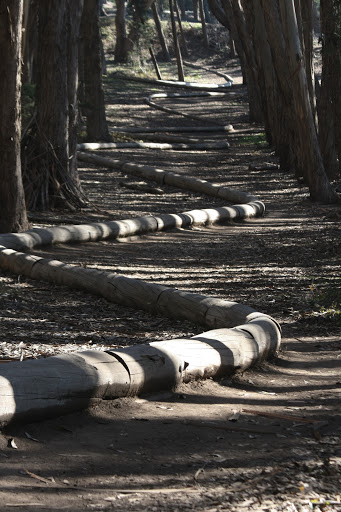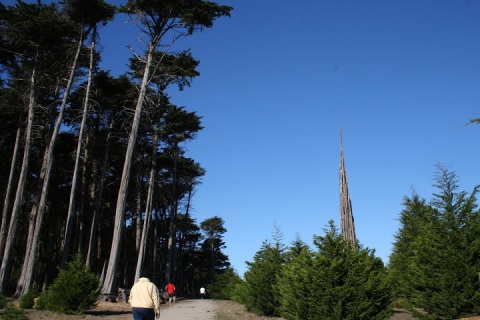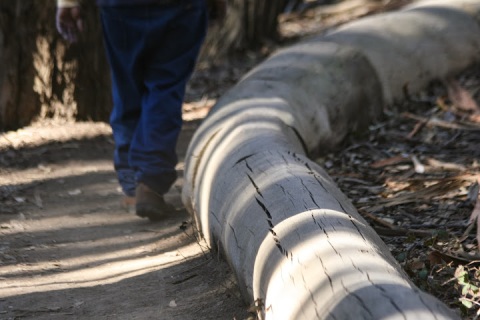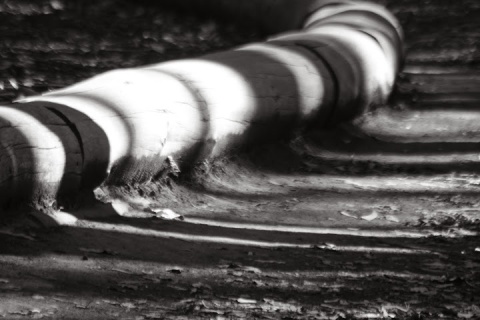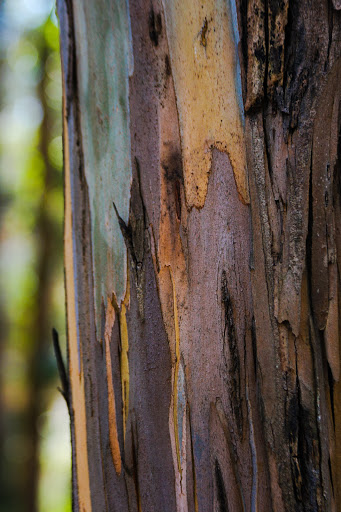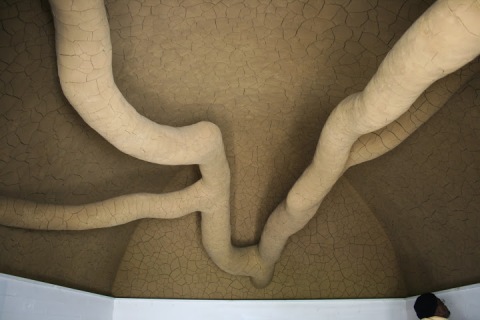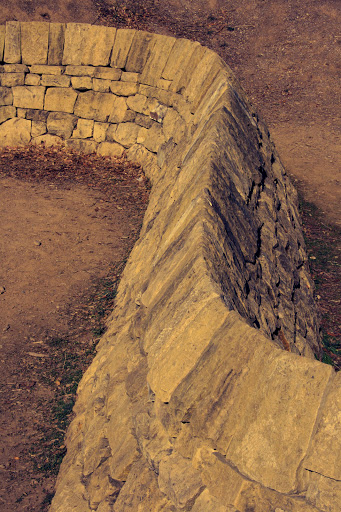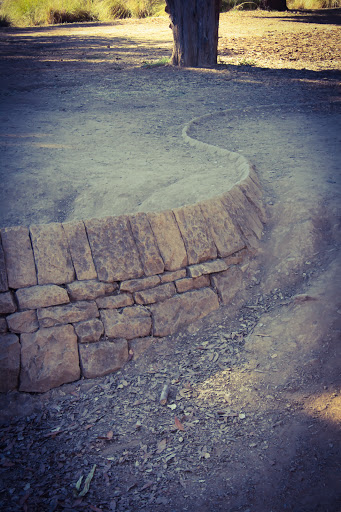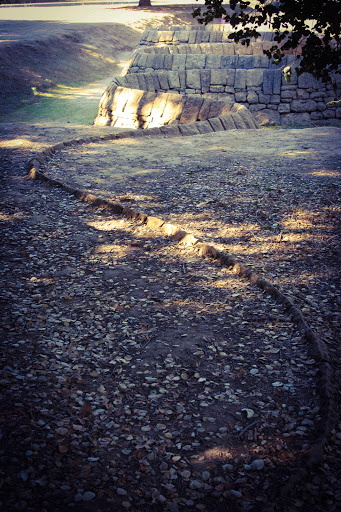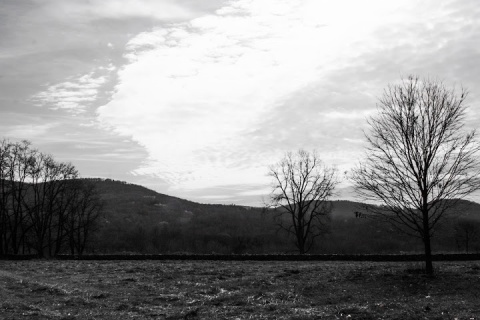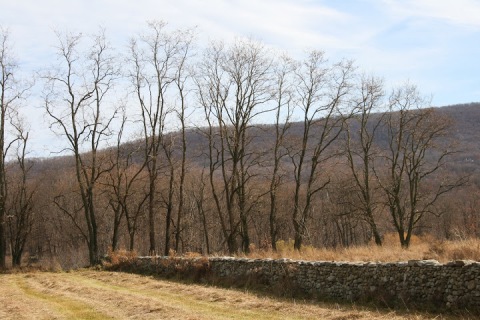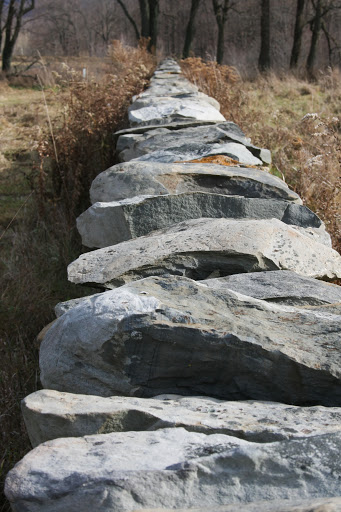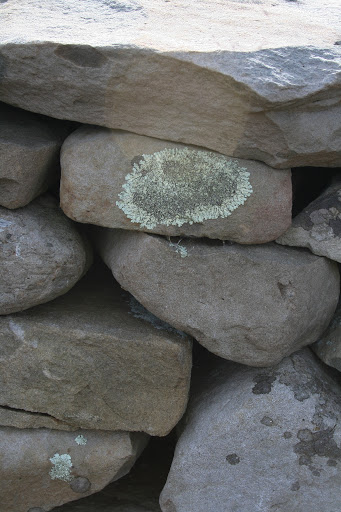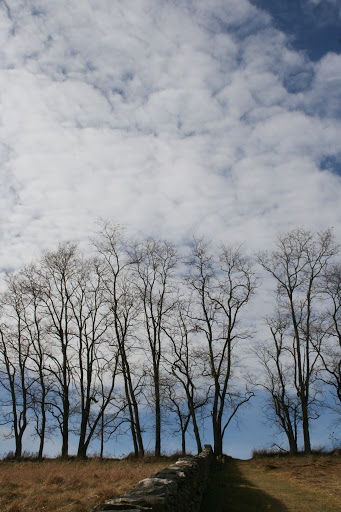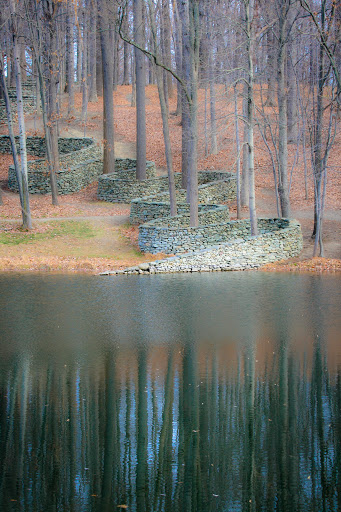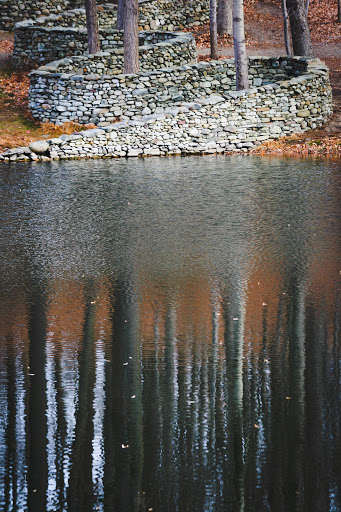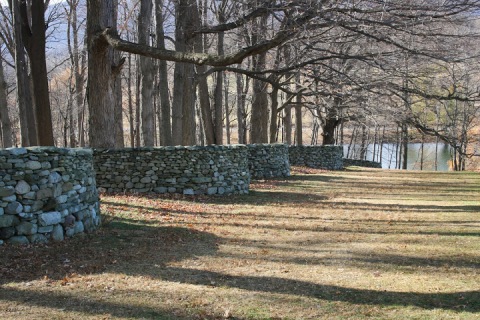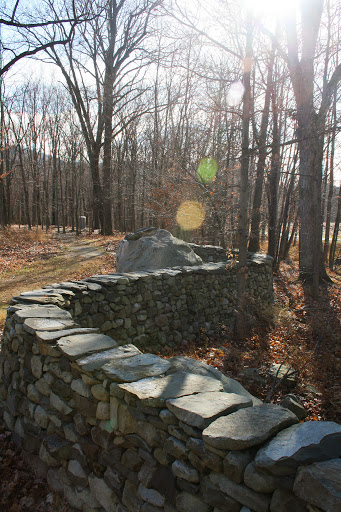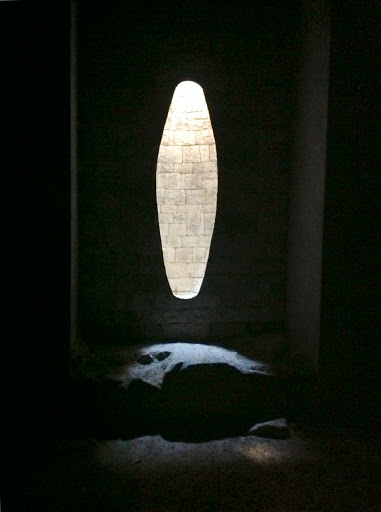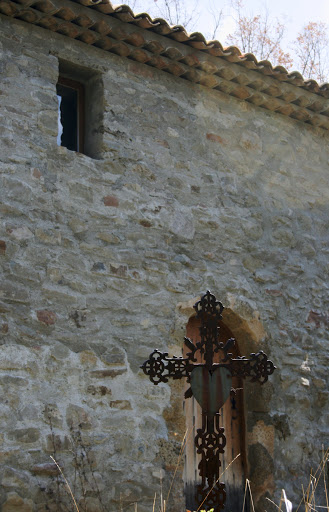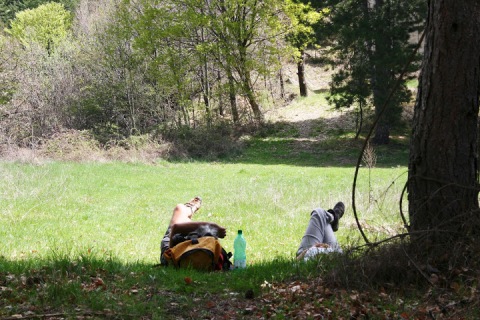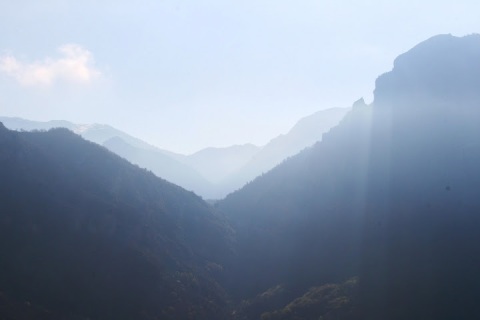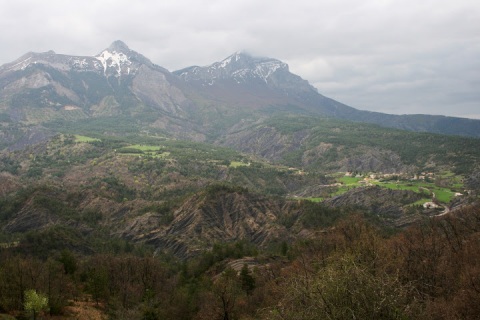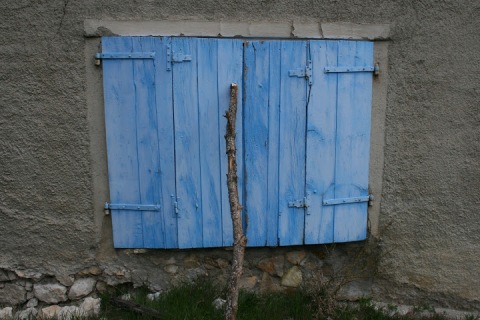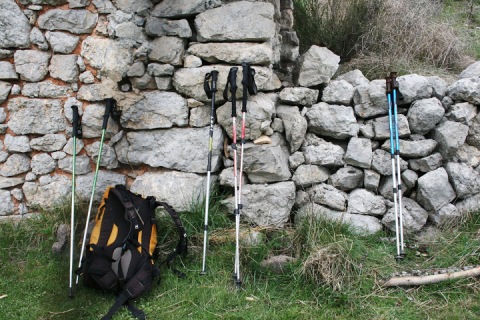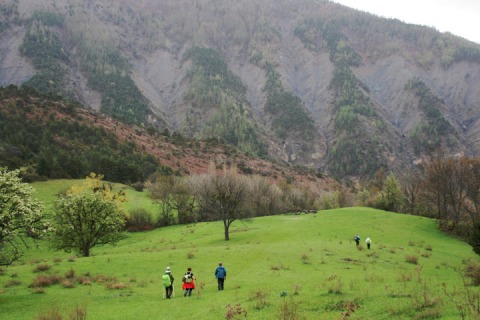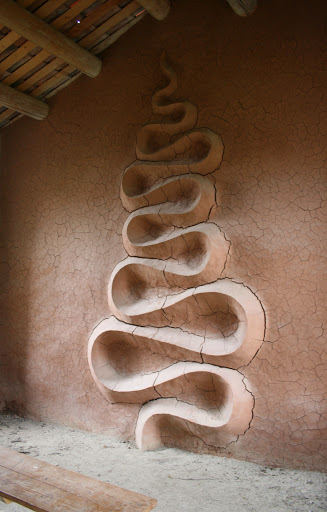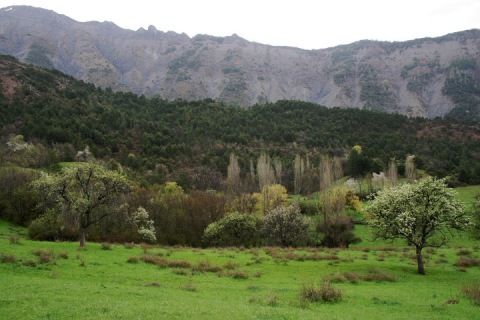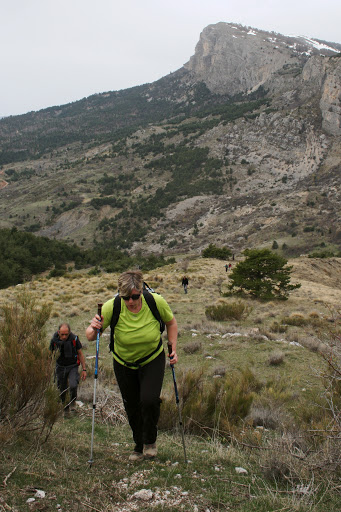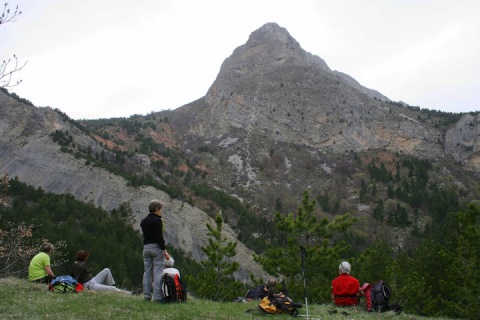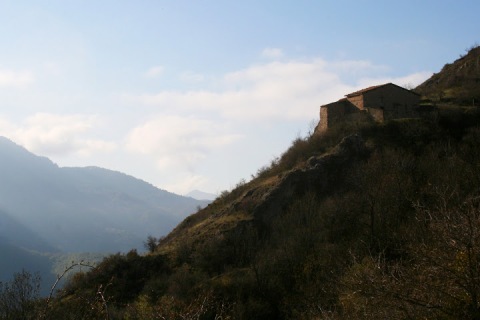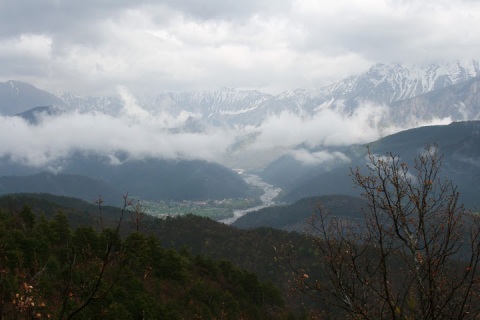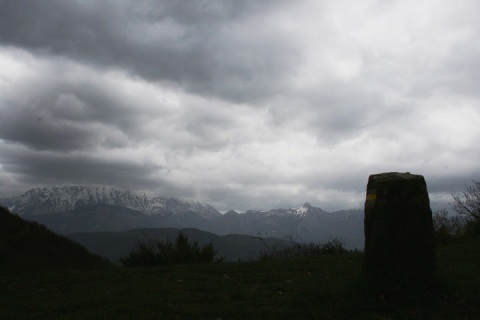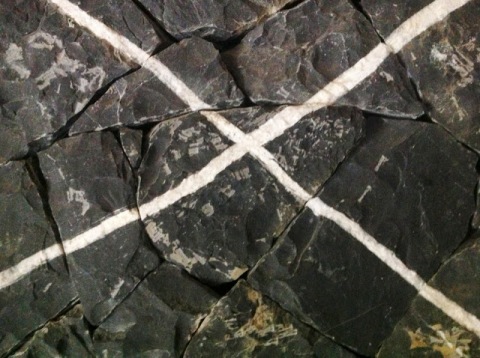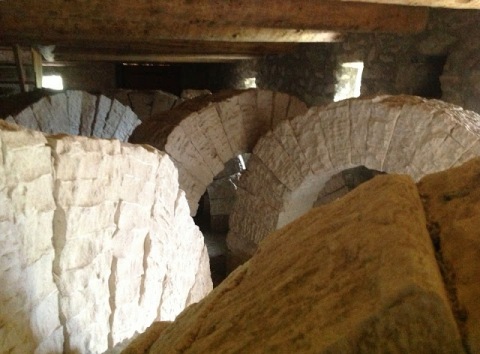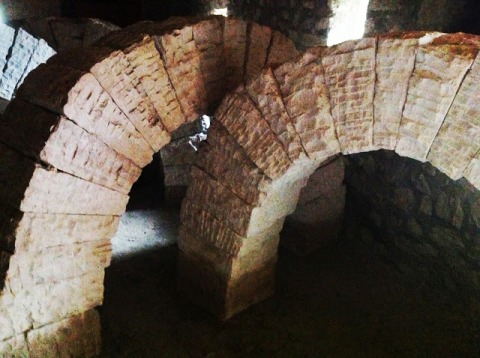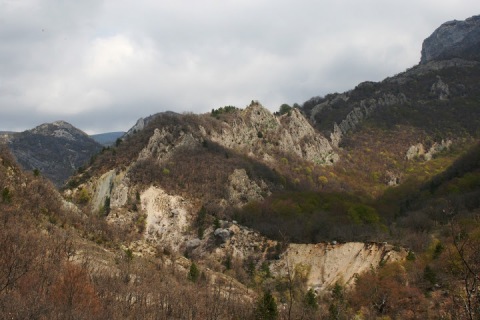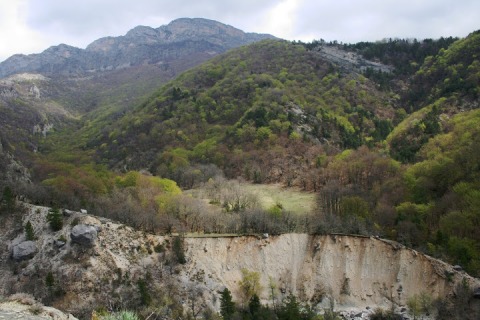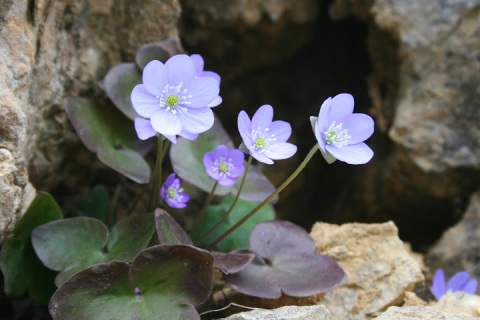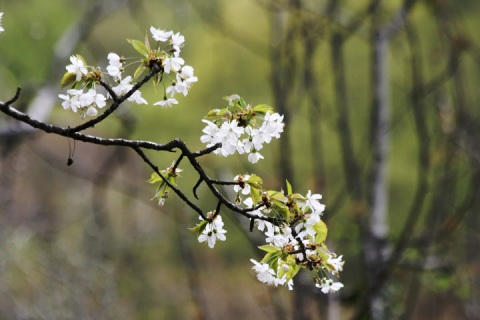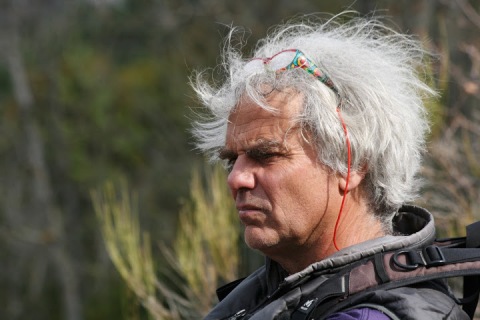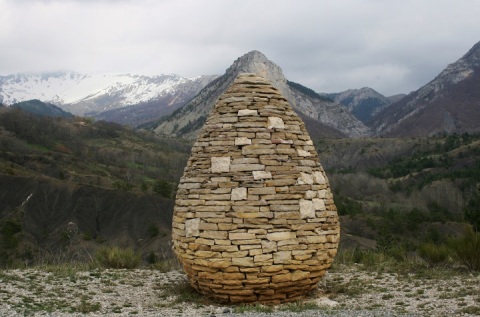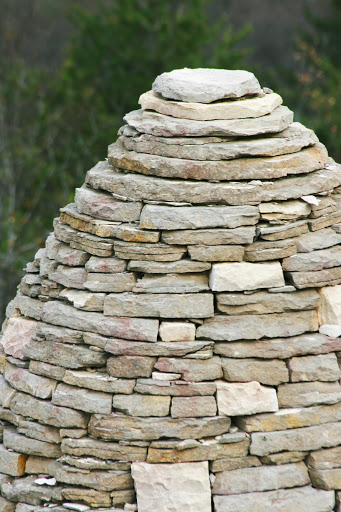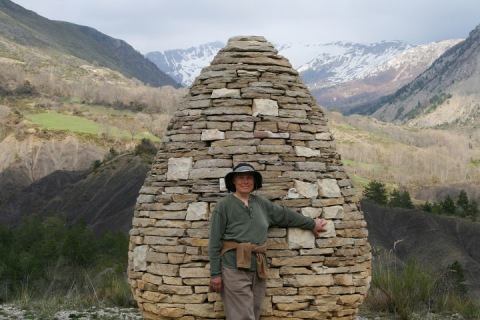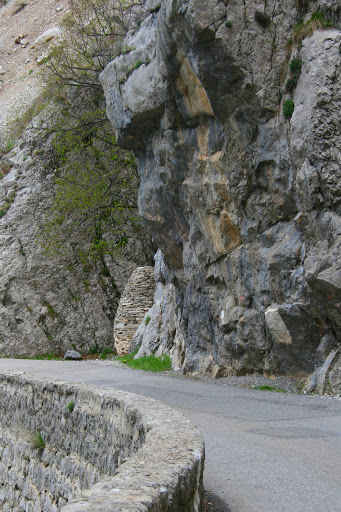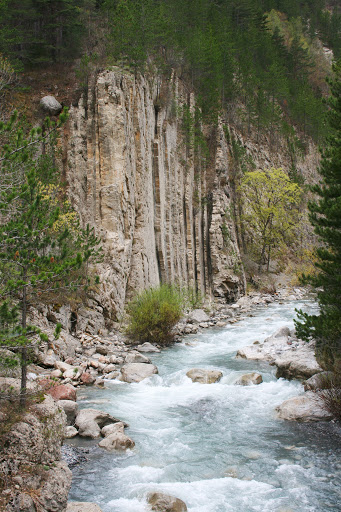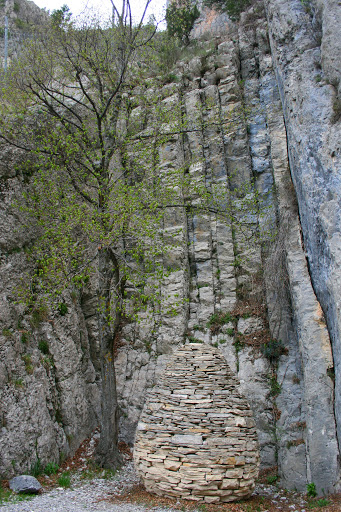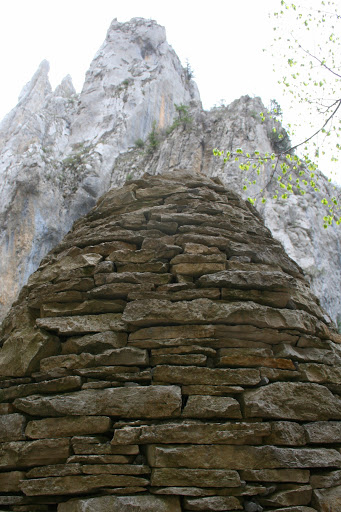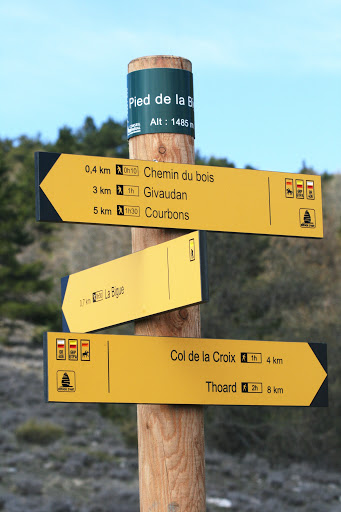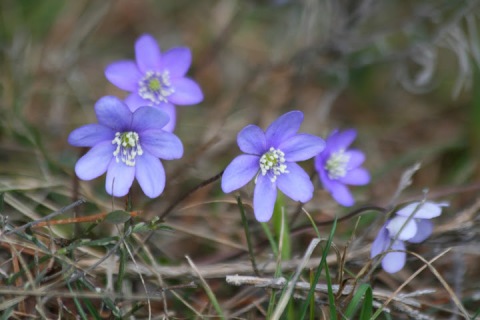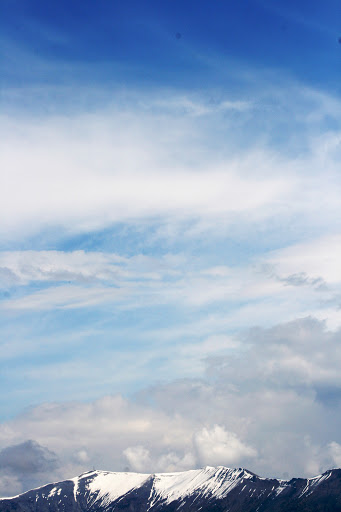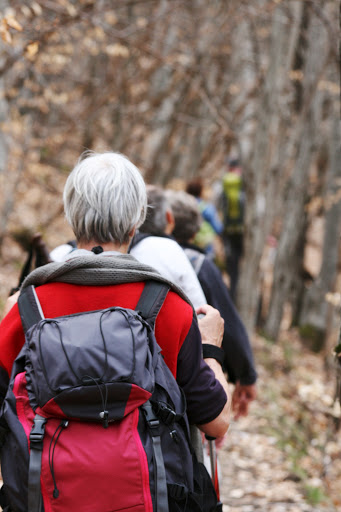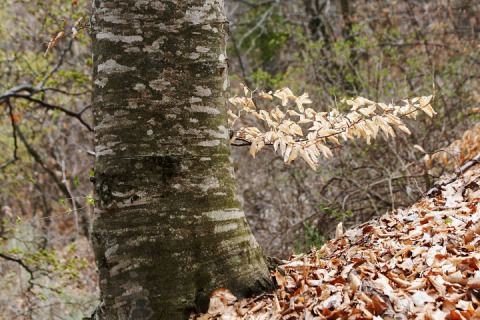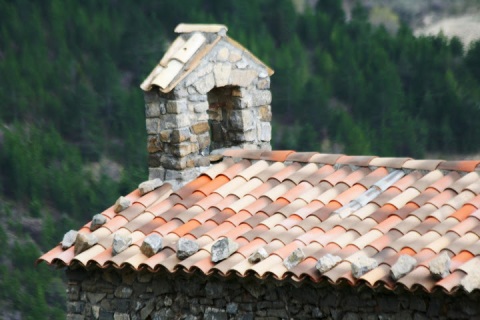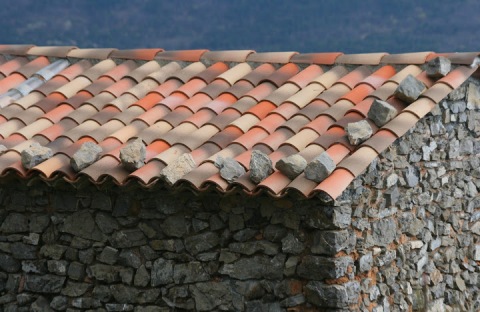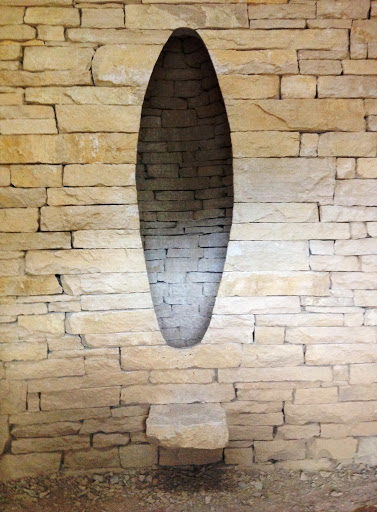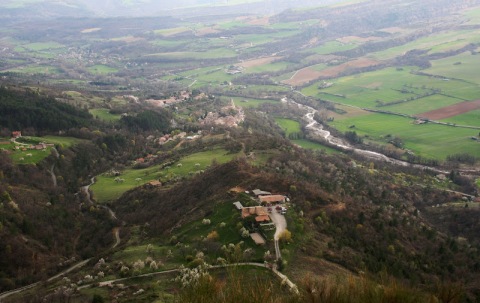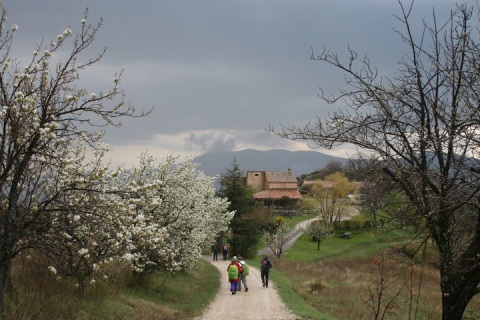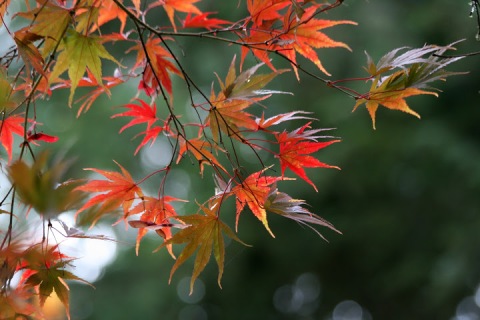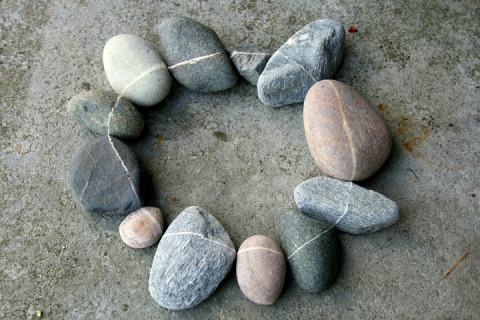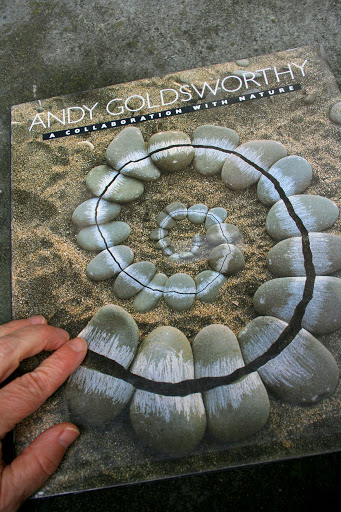Searching for Andy Goldsworthy Art in the Bay Area
January 24, 2014
I have become something of an Andy Goldsworthy groupie. (If you’re a returning reader, you know I’ve written before about the Goldsworthy installations I saw in New York and in France.) When I was planning our trip to California, I did a google search to see whether Goldsworthy has any art in the Bay area — and I learned that he has five pieces including a new one in San Francisco’s Presidio presented in October 2013. That was all the information I needed to set out on a pilgrimage to view his sculptures in their natural settings.
Goldsworthy has three installations in the Presidio. Spire, a 95-foot steeple-like sculpture constructed from 37 large Monterey cypress trunks, was his first and was built in 2008. The Presidio Trust brochure, “Goldsworthy in the Presidio,” says that this artwork “references the architecture of nearby trees but also buildings visible from the site, including the Transamerica Pyramid and church spires. The sculpture is fated to fade into the forest as young cypress trees planted at its base ultimately grow to obscure the piece — like the old forest welcoming the new.”
Goldsworthy’s second Presidio installation (2011) is called Wood Line. It is a curvy, snake-like sculpture made from eucalyptus branches and lies on the sloping ground. The towering eucalyptus trees surrounding Wood Line form a vaulted space like a natural cathedral. This landscape art will deteriorate over time, and the transformative aspect is part of the essence of the piece. I loved the checkered, dappled pattern of the light and shadows on the Wood Line in winter.

Goldsworthy’s newest installation is Tree Fall. It is housed in the tiny historic powder magazine building, so it reminded me of some of his pieces in the refuges along the Goldsworthy hiking trail in France. The Presidio Trust describes this piece as follows: “While Spire articulates the space into which trees grow and Wood Line investigates the relationship of a tree to earth, Tree Fall explores what occurs beneath the ground.” This artwork is comprised of a section of tree that seemingly grows out from a clay-covered ceiling. There is a sense of being underground like a tree root.

The next Goldsworthy installation we saw was in the entry courtyard of the de Young Museum in Golden Gate Park. It is called Drawn Stone, and it is a meandering fissure in the paving stones and stone benches. It seemed to represent a fault line, appropriate to the earthquake-prone city. My husband and I walked right past it, oblivious to its presence until it was pointed out to us by the staff.
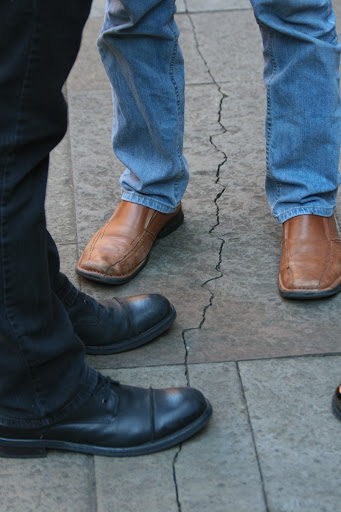
The fifth Andy Goldsworthy installation in the Bay Area is on the Stanford campus. It is called Stone River, and is another of those serpentine sculptures that so captivate the artist. This sculpture is a wall of stone, curving like a snake, and situated in a depression in the earth. The stones were shaped from the debris of university buildings damaged in the 1906 and 1989 earthquakes.
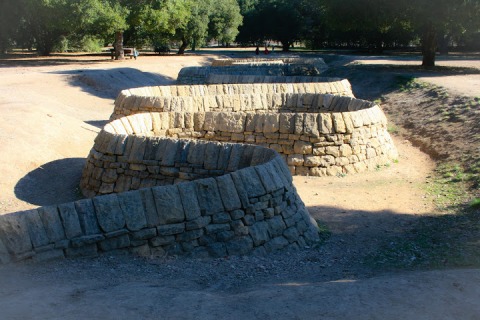
NYC Vignettes: Andy Goldsworthy at Storm King
December 4, 2013
I’ve traveled great distances to see Andy Goldsworthy’s extraordinary art. The last time I was in New York, my husband and I saw his Garden of Stones at the Museum of Jewish Heritage in Lower Manhattan. In April, I went on a five-day guided hike in France where I saw nine Goldsworthy installations along the trail. (You can read about that experience here and here and here.) The $46 bus tour ticket to Storm King to see Goldsworthy’s walls was a much smaller investment than a trip to France, and the rewards of seeing the art in its natural setting was just as satisfying.
I was surprised at how long the wall extended. It started in a straight line atop a hill, then dropped down to a lake, and finally continued in a sinuous curve on the other side of the water. The part that curved around the living tree trunks was quite visible seeing that the trees were bare this late in the season. The lake was like a reflecting pool, magnifying the beauty of this setting.
I was also surprised to learn that Goldsworthy constructed a second wall at Storm King in 2010. Much shorter than his first wall, this one is called 5 Men, 17 Days, 15 Boulders, 1 Wall. I think the title says it all.
Hiking in France 3: Goldsworthy Refuges d’Art
May 28, 2013
“There is this form I can’t stop making which is really snakelike, but I often think of it as a river. It’s the idea of fluidity that is the connection, but I’m not really talking about a river either. It’s the movement that interests me.”
— Andy Goldsworthy, Wall
On Days 3, 4 and 5 of our hike, we saw five Goldsworthy works installed in Refuges d’Art, small buildings or shelters, where individuals are allowed to camp overnight. Our hiking trails took us up and down mountains, across rivers and creeks, with some of the most spectacular scenery of my trip.
We returned to the wild valley of Vancon and hiked to the Church in the abandoned hamlet of Forest. The ruins of the church were restored to house a Goldsworthy wall sculpture, another recessed elliptical space. In contrast to the one at the Chapelle Saint Madeleine, this one was a light hole in a dark wall.
We hiked high in the mountains along an old “tax trail” to the abandoned village of Faissal. We seemed to climb ever higher, with grand views of the distant Alps and curious mountain goats watching us from the summit of an adjacent mountain. And then down, down again.
“Hill and valley followed valley and hill.” — Robert Louis Stevenson, from Travels with a Donkey in the Cevennes
Hiking is much too absorbing to allow much thinking, I’ve found. I moved through the day, step by step, always alert to where I was planting my feet. I didn’t want to slip on a loose rock and fall or hurt myself. I was very much in the moment, a satisfying feeling.
The Refuge of Eschuichiere featured two rooms with wall art fashioned by Goldsworthy of rock with natural lines of contrasting color.
“Stretching out lines that already exist interests me more than imagining new ones. I have made lines that explore and follow the contours of a rock, the edge of a river, the growth of a branch, the junction between house and street . . . The intention is not just to make a line, but to draw the change, movement, growth and decay that flow through a place.”
— Andy Goldsworthy, Wall
At the end of Day 5, our guide Eric drove us in the van to the farm Belon, which was formerly owned by one of the leaders of the French Resistance in WWII. In the basement we found several of Goldsworthy’s stone arches. One of our hikers, Michele, mused about the significance of this “underground” space and its resonance with the “underground” resistance movement.
I found the entire five-day hiking experience very rewarding. Not only did I get to see some Goldsworthy art that I would never have been able to find on my own, I also enjoyed the company of some French natives on their home turf. It made me realize how difficult it is for me when travelling to spend ordinary time with local people. Typically I am staying in hotels, eating in restaurants, and going to tourist sites — with a bunch of other tourists. With this guided hike, I had the unusual (for me) opportunity to keep company with some interesting French people, share home-cooked meals at farm tables with them, and even sleep in shared rooms in auberges and gites. I found that they are great conversationalists (even though I could not understand or speak French, they made an effort to speak English from time to time, and I watched their lively conversations with interest), they were enthusiastic eaters and enjoyed leisurely meals together, they were well read, and they liked President Obama!
Hiking in France 2: Andy Goldsworthy Sentinels
May 27, 2013
Andy Goldsworthy built three sentinels in this part of France, and we hiked to two of them — the Authon sentinel on Day 2 and the sentinel in the valley of Bes on Day 4. All are accessible by road, but Jean-Pierre felt that hiking to them would give us a better feel for the land elements that inspired Goldsworthy. The sentinels stand like guardians in the landscape. Although there is no mortar in the stacked stones, they are solidly built — sturdy and steadfast.
Day 2 was perhaps the most challenging day of hiking for me. We were on the trail from 9:00 a.m. to 5:30 p.m. Jean-Pierre had to make last-minute changes to our planned itinerary. We were to have sheltered for the night in one of the Refuges d’Art (huts that housed a Goldsworthy sculpture), but the mountain road was too muddy, and it was impossible to get a vehicle up there with our heavy bags and camping supplies. The adapted itinerary kept us hiking, sometimes off trail, and through more difficult terrain, for a longer-than-normal day. At times I felt like a mountain goat! My worst moment was slipping on a rock and stepping one foot into slimy, smelly swamp sludge. There was also a scary traverse across scree, short, but Jean-Pierre escorted us safely across one by one. I had a terrific workout, and the reward for the day’s efforts was seeing the first of Andy Goldsworthy’s sentinels.
On Day 4, after another day of hiking, we saw a second Goldsworthy sentinel in the valley of Bes. This one was situated in a natural alcove in the looming rock. It felt like a tiny beacon in a dominating landscape, and yet it felt protected, sheltered and cocooned.
Hiking in France 1: On the Trail of Andy Goldsworthy
May 26, 2013
I signed up for this guided hike for the chance to see Andy Goldsworthy’s sculptures, but I was blown away by the spectacular scenery. On Day 1, we hiked from the village of Courbons to Thoard. Our destination was the tiny Chapelle Saint Madeleine, perched near the summit of a hill/mountain, which featured a wall sculpture by Goldsworthy.
The marked trail took us up over the hilltops and gave us awesome views of the surrounding snow-capped mountains. It continued through a forest of beech trees; the fallen beech leaves provided a soft, but slippery, cushion of padding on the path. I was challenged to keep up with the group, all experienced and hearty hikers, but I was exhilarated at the same time to be in France, on this hike — a dream coming true.
Near the end of the day’s hike, we approached the tiny Chapelle Saint Madeleine via a gravel road that passed lavender fields. The chapel, like many of the buildings in this area, had a tile roof of the most pleasing orangy colors. The tiles were held down with stones. Inside, on the wall where the altar would have been, was a recessed elliptical-shaped space large enough to stand in. Goldsworthy intended this as an introspective space, a contrast to the vast expanse of the vista looking down into the valley just outside the door.
Japanese Maples as Objects of Envy
November 7, 2012
Pebbles and Friendship
October 29, 2012
Pebbles
by Valerie Worth, from All the Small Poems and Fourteen More
Pebbles belong to no one
Until you pick them up —
Then they are yours.
But which, of all the world’s
Mountains of little broken stones,
Will you choose to keep?
The smooth black, the white,
The rough gray with sparks
Shining in its cracks?
Somewhere the best pebble must
Lie hidden, meant for you
If you can find it.
My new friend Bonnie gave me this collection of assorted stones with white lines. She said the circle represents her circle of friends, and I will be reminded of her friendship, in particular, whenever I look upon my necklace of stones.
Making art from rocks and other natural objects reminds me of Andy Goldsworthy sculptures, such as this spiral of broken pebbles scratched white with another stone (1985, The Borders).
